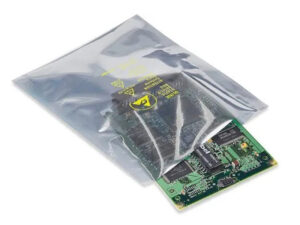
ANTISTATIC BAGS
An antistatic bag is a bag used for storing electronic components, which are prone to damage caused by electrostatic discharge (ESD).
These bags are usually plastic polyethylene terephthalate (PET) and have a distinctive color (silvery for metallised film, pink or black for polyethylene). The polyethylene variant may also take the form of foam or bubble wrap, either as sheets or bags. Multiple layers of protection are often used to protect from both mechanical damage and electrostatic damage. A protected device can be packaged inside a metalized PET film bag, inside a pink polyethylene bubble-wrap bag, which is finally packed inside a rigid black polyethylene box lined with pink poly foam. It is important that the bags only be opened at static-free workstations.
Dissipative antistatic bags, as the name suggests, are made of standard polyethylene with a static dissipative coating or layer on the plastic. This prevents buildup of a static charge on the surface of the bag, as it dissipates the charge to ground.
Conductive antistatic bags are manufactured with a layer of conductive metal, often aluminum, and a dielectric layer of plastic covered in a static dissipative coating. This forms both a shield and a non-conductive barrier, shielding the contents from static charge via the Faraday cage effect. These bags are preferred for more sensitive parts, but they also see use in environments where sparks would be hazardous, such as oxygen-rich areas in aircraft and hospitals. Metalized bags are more fragile than their nonmetal counterparts, however, as any puncture compromises the integrity of the shield. In addition, they have a limited shelf life, as the metal substrate can deteriorate over time. These bags are often gray or silver owing to the metal layer, while still being transparent to some degree.
ESD bags for packaging of materials such as fragile Materials, ESD equipment’s and ESD consumables are protected by these type of packaging materials.
1. ANTISTATIC Bubble Bag
The bubbles that provide the cushioning for fragile or sensitive objects are generally available in different sizes, depending on the size of the object being packed, as well as the level of cushioning protection needed. Multiple layers may be needed to provide shock and vibration isolation, while a single layer may simply be used as a surface protective layer. Bubble wrap is also used to form some types of mailing envelopes.
Bubble wrap is most often formed from polyethylene (LDPE) film with a shaped side bonded to a flat side to form air bubbles. Some types of bubble wrap have a lower permeation barrier film to allow longer useful life and resistance to loss of air in vacuums.
The bubbles can be as small as 6 millimetres (0.24 inches) in diameter, to as large as 26 millimetres (1.0 inch) or more, to provide added levels of shock absorption during transit. The most common bubble size is 1 centimeter. In addition to the degree of protection available from the size of the air bubbles in the plastic, the plastic material itself can offer some forms of protection for the object.
Pink bubble bags with anti-static range are available with various range of sizes and specifications.


Specification
| Tensile Strength | 185 kg/cm' |
| Tear Strength | 1200 g |
| Sealing Time | 0.5 - 5 sec |
| Sealing Temperature | 82 - 121 ·c |
2. MBB & SSB BAGS
Many devices and components require protection from both. Stat shield Moisture Barrier Bags (MBB) are designed to protect the contents from both moisture and ESD events. MBBs protect ESD susceptible devices by forming a faraday cage around the contents, protecting the contents from moisture with specialized layers of film that control the Moisture Vapor Transfer Rate.
The bags come with transparent shielding bag or opaque moisture barrier bag Depending upon the requirement. With required microns and specifications, the ESD bags are supplied accordingly.
These bags protect the packed components dust and moist free and can be heat sealable. These bags are best recommended for the package of electronic components such as PCB boards and microchips.

Aluminium Moisture Barrier Bag


